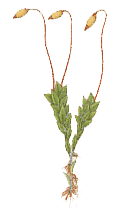
Introduction
What's in this site and what isn't
Bryophyte is the collective name for the mosses, liverworts and hornworts. They are all plants and this website introduces you to the basics of bryophytes.
Bryophytes are very common, even in urban areas and many people have seen them, though in many cases they're all likely to be lumped together as "mosses". As you'll find out, many "mossy things" are not mosses. A range of species feature in the composite image on the opening page of this website.
The aim is to cover a broad range of topics and give you more than just a very superficial account of each. However, the website is not an overly technical one so that a bryophyte expert will find nothing new here.
You don't need to know anything about bryophytes before starting on this website. The best starting point for someone who knows nothing about bryophytes is the WHAT IS A BRYOPHYTE? page. It gives a short summary of the fundamental bryophyte facts. Moreover, the links in that page will take you to various other sections for more information about topics that interest you.
This website will not help you identify bryophytes to species. There are various printed and electronic sources that will help you in that. In the FURTHER READING SECTION you'll find an annotated bibliography that should help you in your search for such sources.
The photographs
Virtually all the photographs used in this website show bryophytes that are found in Australia. Many are endemic, but there are also species which are naturally widespread as well as those that have been unintentionally introduced. In a few cases there are photographs of bryophytes that are not known to occur in Australia - but that will be made clear.
The links, camera, reference and case study icons within the text
Most photos on the page are linked to larger versions of the same photo - just click on the photo to bring up the larger image in a new window. Close that window before proceeding.
There are many photos and drawings in the text, and you can bring up additional photos whenever you see this camera icon: ![]()
Just click on the icon to see the photo in a new window.
From time to time you’ll see grey Reference buttons which look like this: ![]()
If you click on such a button you’ll find references to more detailed information (generally in books or journals) about the topic being discussed at that point. The references vary in level (some simple, others quite technical) but you don’t need them to get a good grasp of the basics. The website will do that, so you can safely ignore the references knowing that you are not missing out on anything fundamental. The references are there simply for those who’d like to follow up a topic in more depth. Close the little reference window before proceeding further.
Links in underlined UPPER-CASE lettering take you to different areas of the bryophyte web site. While most other links open up new windows within your current page, these links take you to new pages.
There are a some CASE STUDIES that are referred to at various parts of the website. A case study is a more detailed account, of say a particular species, that is used to go a little more deeply into some point. The discussion may be too long or perhaps a little too technical to sit well in the main body of the website. So the case studies are kept in a separate CASE STUDIES SECTION. In this way there is no interruption to the flow of the text in the main body. However, there will always be a brief summary of the issue in the main body, to let you immediately pick up the main points of the case study. As in the case of the references in the REFERENCE buttons, if you ignore the case studies you will still get a very good grasp of the basics. You can open up a case study by clicking on the case study icon:
The painting at the top of a page
In many cases you'll see a painting of a bryophyte at the top of a page. These come from one of the following books:
Handbook of British Mosses (2nd. ed.)
M.J. Berkeley
Published in London in 1895
Die Lebermoose Deutschlands
G. Hahn
Published in Gera in 1885
Kryptogamen-Flora von Deutschland, Deutsch-Österreich und der Schweiz: Band 1: Moose
W. Migula
Published in Berlin in 1934
In one case there'll be a painting of a lichen, taken from:
English Botany or, Coloured Figures of British Plants, Volume XXXV
J.E. Smith (with the figures by J. Sowerby)
Published in London in 1813
If you position your cursor over the image a small box will pop up, giving the source for each painting and a species name. The species name will be that used in the original publication. The modern scientific names for some of the species that feature in those paintings may be different.
Friends of the Australian National Botanic Gardens
This web site was sponsored by the Friends of the Australian National Botanic Gardens, a non-profit support group for the Australian National Botanic Gardens. One of the objectives of the Friends is providing information and education to the community about growing, studying and promoting Australian plants. The Friends provided generous funding for the author, Heino Lepp, an Honorary Associate of the Gardens to write and develop this web site.
![An Australian Government Initiative [logo]](/images/austgovt_brown_90px.gif)

